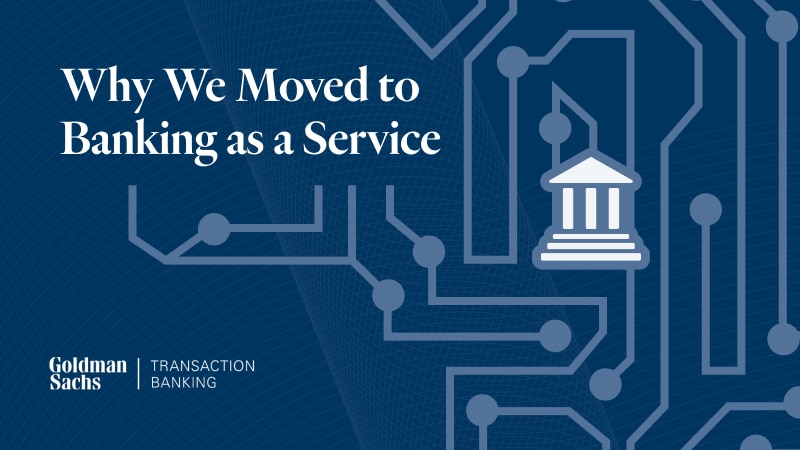Why We’ve Moved Into Banking as a Service

By Luc Teboul – MD, Head of Engineering, Transaction Banking
As Goldman Sachs Transaction Banking (TxB) set out to build its platform a couple years ago, we had a clear focus on meeting the needs of treasury clients in search of a better, fully digital system. We chose ourselves as our first client, figuring that if we worked from a blank sheet to meet the complex treasury needs of a company like Goldman Sachs, we would be well on our way. This was a challenging test for a new transaction banking platform, but it paid off and has helped us to prove that we built our platform right.
It didn’t take long to realize, however, that we were developing a system that could be shared with a larger universe of digitally savvy clients—not just corporate treasury clients but also fintechs and e-commerce marketplaces. That’s how we entered the Banking as a Service (BaaS) sphere, recognizing that we had something unique to offer there too.
I recently walked through this story, about how Goldman Sachs got into BaaS, as a speaker at Tearsheet’s Embedded Conference. My talk garnered a lot of audience interest, so I thought it would be worth expanding on it here. Goldman Sachs brings unique advantages to BaaS that may not be immediately obvious, and may be worth explaining in greater detail.
Table stakes for BaaS
The first thing to understand is that BaaS places a number of requirements on the provider. These services, if you get them right, are not just a technological challenge: They fall right at the junction of technology and banking.
The first requirement, of course, is state-of-the-art technology, which we bring to the table with our cloud native, fully API-based platform. Systems need to be fully scalable and secure. Services need to make a rich feed of real-time data easily accessible to clients and partners. Equally important, though, the BaaS provider needs to have a banking license and the ability to conduct financial services across numerous jurisdictions. Along with that comes the need for robust compliance, regulatory and legal functions and the expertise to manage a balance sheet.
Goldman Sachs brings these things together in a way that most other organizations in the emerging BaaS realm do not.
The competitive landscape
I currently see three main entrants in the BaaS space.
- Fintechs. These players are likely to provide a modern platform but usually work with a banking partner.
- Regional banks. Smaller banks are offering BaaS directly.
- Large banks. As incumbents in the transaction banking business, these players have the banking licenses and the compliance, regulatory and legal expertise. They have deep expertise about how to manage a balance sheet but often lack the modern technology platform.
Where does Goldman Sachs TxB fit in this competitive landscape? We believe that we have certain advantages against players in each of these categories. Our fintech-like platform gives us better technology than the large banks, and our banking expertise gives us financial capabilities that the small banks and fintechs can’t offer. It’s a best of both worlds proposition that very few of our competitors—if any—can match.
Another important aspect of BaaS is the ability to create an end to end solution with your partners. That’s another place where our deep financial expertise comes into the picture. To deliver a successful BaaS experience you need to co-design the solution with your partner. There are many dimensions to take into account when you do this. Is your partner licensed? Who are the clients? What kind of activities and flows do they undertake? In which countries and jurisdictions will they need services? All these aspects have a meaningful impact on how you position the platform. We have an extremely talented and knowledgeable BaaS Team, and they are key in any successful offering—as shown with our recent partnership with Stripe.
There were a number of companies we looked to for inspiration as we developed our platform and pushed into BaaS. We were searching for examples of those who have successfully developed and scaled products that they offer as a service—and most of those happen to be in technology fields. We took inspiration from how cloud providers have enabled a new era of products, and we began to see how we could build the Goldman Sachs Financial Cloud to become a similar enabler for companies that want to innovate within financial services.


